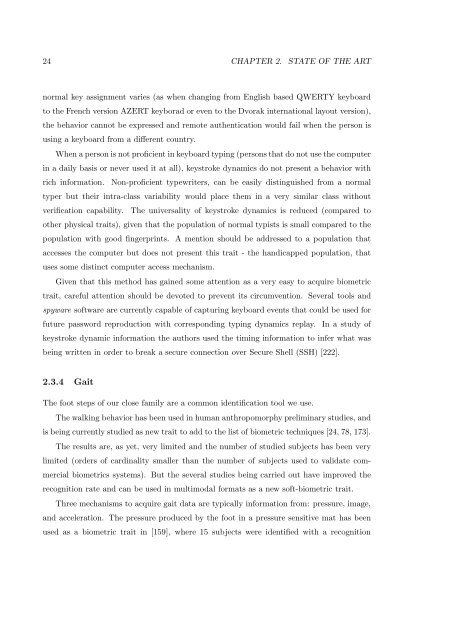Thesis - Instituto de Telecomunicações
Thesis - Instituto de Telecomunicações
Thesis - Instituto de Telecomunicações
Create successful ePaper yourself
Turn your PDF publications into a flip-book with our unique Google optimized e-Paper software.
24 CHAPTER 2. STATE OF THE ARTnormal key assignment varies (as when changing from English based QWERTY keyboardto the French version AZERT keyborad or even to the Dvorak international layout version),the behavior cannot be expressed and remote authentication would fail when the person isusing a keyboard from a different country.When a person is not proficient in keyboard typing (persons that do not use the computerin a daily basis or never used it at all), keystroke dynamics do not present a behavior withrich information. Non-proficient typewriters, can be easily distinguished from a normaltyper but their intra-class variability would place them in a very similar class withoutverification capability. The universality of keystroke dynamics is reduced (compared toother physical traits), given that the population of normal typists is small compared to thepopulation with good fingerprints. A mention should be addressed to a population thataccesses the computer but does not present this trait - the handicapped population, thatuses some distinct computer access mechanism.Given that this method has gained some attention as a very easy to acquire biometrictrait, careful attention should be <strong>de</strong>voted to prevent its circumvention. Several tools andspyware software are currently capable of capturing keyboard events that could be used forfuture password reproduction with corresponding typing dynamics replay. In a study ofkeystroke dynamic information the authors used the timing information to infer what wasbeing written in or<strong>de</strong>r to break a secure connection over Secure Shell (SSH) [222].2.3.4 GaitThe foot steps of our close family are a common i<strong>de</strong>ntification tool we use.The walking behavior has been used in human anthropomorphy preliminary studies, andis being currently studied as new trait to add to the list of biometric techniques [24, 78, 173].The results are, as yet, very limited and the number of studied subjects has been verylimited (or<strong>de</strong>rs of cardinality smaller than the number of subjects used to validate commercialbiometrics systems). But the several studies being carried out have improved therecognition rate and can be used in multimodal formats as a new soft-biometric trait.Three mechanisms to acquire gait data are typically information from: pressure, image,and acceleration. The pressure produced by the foot in a pressure sensitive mat has beenused as a biometric trait in [159], where 15 subjects were i<strong>de</strong>ntified with a recognition
















